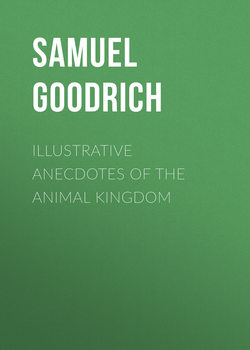Читать книгу Illustrative Anecdotes of the Animal Kingdom - Goodrich Samuel Griswold - Страница 9
VERTEBRATA
CLASS MAMMALIA
ORDER III.
CARNARIA,
BUTCHERING ANIMALS
BATS
ОглавлениеThese creatures, partaking both of the nature of quadrupeds and birds, have excited the wonder of mankind in all ages. There is a great variety of species, from the common bat of our climate to the vampyre of South America, whose wings stretch to the extent of two feet. These animals live in caves and crevices during the day, and sally forth at evening to catch their prey. For this reason, there is a popular disgust of the whole tribe; yet the species in our climate are a harmless race. We cannot say as much of the larger kinds, which sometimes darken the air, by their abundance, in hot climates. One species, already mentioned, is a formidable animal.
Captain Stedman, in his "Narrative of a Five Years' Expedition against the revolted Negroes of Surinam," relates that, on awaking about four o'clock one morning in his hammock, he was extremely alarmed at finding himself weltering in congealed blood, and without feeling any pain whatever. "The mystery was," says Captain Stedman, "that I had been bitten by the vampyre, or spectre of Guiana, which is also called the flying dog of New Spain; and by the Spaniards, perrovolador. This is no other than a bat of monstrous size, that sucks the blood from men and cattle, while they are fast asleep, even, sometimes, till they die; and, as the manner in which they proceed is truly wonderful, I shall endeavor to give a distinct account of it.
"Knowing, by instinct, that the person they intend to attack is in a sound slumber, they generally alight near the feet, where, while the creature continues fanning with his enormous wings, which keeps one cool, he bites a piece out of the tip of the great toe, so very small, indeed, that the head of a pin could scarcely be received into the wound, which is, consequently, not painful; yet, through this orifice, he continues to suck the blood, until he is obliged to disgorge. He then begins again, and thus continues sucking and disgorging until he is scarcely able to fly, and the sufferer has often been known to pass from time to eternity. Cattle they generally bite in the ear, but always in places where the blood flows spontaneously. Having applied tobacco ashes as the best remedy, and washed the gore from myself and hammock, I observed several small heaps of congealed blood, all round the place where I had lain, upon the ground; on examining which, the surgeon judged that I had lost at least twelve or fourteen ounces of blood."
"Some years ago," says Mr. Waterton, in his "Wanderings in South America," "I went to the River Paumaron, with a Scotch gentleman, by name Tarbet. We hung our hammocks in the thatched loft of a planter's house. Next morning, I heard this gentleman muttering in his hammock, and now and then letting fall an imprecation or two, just about the time he ought to have been saying his morning prayers. 'What is the matter, sir?' said I, softly; 'is any thing amiss?' 'What's the matter?' answered he, surlily; 'why, the vampyres have been sucking me to death.' As soon as there was light enough, I went to his hammock, and saw it much stained with blood. 'There,' said he, thrusting his foot out of the hammock, 'see how these infernal imps have been drawing my life's blood.' On examining his foot, I found the vampyre had tapped his great toe. There was a wound somewhat less than that made by a leech. The blood was still oozing from it. I conjectured he might have lost from ten to twelve ounces of blood. Whilst examining it, I think I put him into a worse humor, by remarking that a European surgeon would not have been so generous as to have blooded him without making a charge. He looked up in my face, but did not say a word. I saw he was of opinion that I had better have spared this piece of ill-timed levity."
